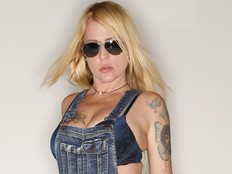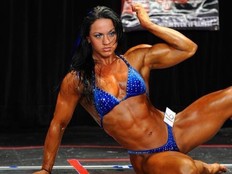Flip-flops are the shoe of the summer. Duh!

Article content
Reviews and recommendations are unbiased and products are independently selected. Postmedia may earn an affiliate commission from purchases made through links on this page.
Stylish Americans are making a bold fashion choice this summer: flip-flops.
Wait. Flip-flops, for summer? Isn’t that like saying winter is a great time to wear snow boots? To quote Miranda Priestly in “The Devil Wears Prada”: “Groundbreaking.”
Recommended Videos
And yet the fashion press and social media users alike have anointed the humble flip-flop “the shoe of the summer.” Substackers such as Max Berlinger, Jalil Johnson and Liv Perez have written paeans to their rubbery, snappy charms. On Instagram, menswear fanatics are having a meltdown over whether to wear pricey designer versions or their dupes. At Men’s Fashion Week and Couture Week in Europe earlier this summer, flip flops were seen on show attendees, styled with drapey tailoring and cocktail dresses. Pop star Sabrina Carpenter was celebrated for wearing US$4 Old Navy flip flops instead of The Row’s trendy $690 (yes, you read that right) version.
“The big difference, for me – I have been seeing more people wearing flip-flops in the city,” said Lawrence Schlossman, the co-host of the menswear podcast “Throwing Fits.” “That is different.” Obviously people have always worn flip-flops by the pool or at the beach, but now they have become a more everyday shoe option. “People wearing them with jeans to get beers with the homies at Fanelli – that definitely is a new development.”
In late July, the Venice Beach-based designer Eli Russell Linnetz released his brand ERL’s own take on the high-end flip-flop, in “Low” ($185), a five-inch platform “Big” ($375) and an outrageous eight-inch-sole “Huge” ($1250, available by request only). Within minutes, he said, the flip-flops sold out. He accompanied their release with some of his signature imagery, which is often highly sexualized to the point of hilarious discomfort or lascivious escapism or both. (Linnetz has shot covers for GQ Magazine and directed Kanye West’s “Fade” music video, and is also in preproduction for his first film.)
Here, there was a female model riding a male model, both nude except for their flip flops, and another nude model posing like a Greek statue (or a Versace model ad from the label’s 1990s prime) in the Huge. Before Instagram took down the post of the couple, Linnetz said, it had over 5 million views. “People loved it or hated it,” he said.
ERL, which Linnetz launched in 2020, has long used flip-flops almost as its uniform shoe, styling them with suiting, gym clothes. While he produces many styles of shoe, he produced the flip-flop as a mischievous way to remind consumers that he was the first designer to put his finger on the style as a fashion object.
“It felt like someone was stealing a piece of something that was always a part of who we are,” he said. “It’s like the line from ‘Titanic.'” He giggled, recalling a scene between Rose and Jack in the film. “She was like, I’m in a room screaming at the top of my lungs and no one can hear me. So that’s where the big flip-flops came from.”
The flip flop frenzy marks a larger turn in fashion: a movement away from the Y2K redux styles that have dominated for several years, and more toward a mall-jock breed of prep.
“If we were to look at the last couple major fashion trends, with how things evolved from normcore to Y2K – the look that had not been mined until recently was like, the Abercrombie, Hollister, Pacsun kind of preppy,” said Schlossman. Shoppers have plundered the archives of the Gap, Hot Topic and J.Crew. “The next thing, the obvious extension is, ‘What is the part of the mall that we haven’t hit?'”
He points to designers Linnetz, Raimundo Langlois, whose clothes are like a Tina Barney imagining of Abercrombie’s controversial early 2000s catalogues, and stylist Marcus Allen of the Society Archive, who often pulls vintage Abercrombie for his photoshoots, for pushing the fashion narrative in this direction over the past few years. Now, larger brands like Jonathan Anderson’s Dior, Pharrell’s Louis Vuitton and Michael Rider’s Celine are adapting that popped collar mentality.
And the flip-flop, the go-to shoe for bros clad in cargo pants and tight polos, is this style’s most accessible product. “Not everyone wants a huge cargo short. Not everyone wants a tiny cute polo that’s going to show off your midriff, or puka shell necklaces or whatever,” said Schlossman. “But flip-flops, they’re always there. We’re always on the beach. We’re always going to be at the pool. It’s going to be hot: Let the dogs breathe.”
While Havaianas, which sell for about $30, have been embraced as an affordable fashion it-item in the vein of Adidas Stan Smiths or Birkenstocks, it is the Row’s $690 Dune that has been the point of controversy. Is it ridiculous to spend that much on a rubber and grosgrain sandal when there is no label or special design to let the world know what you forked over for it?
“One side of the argument is like, flip flops are gross, stupid, childish, immature, not sophisticated. You know, who wants to see a man’s feet in the street?” said Schlossman, who has a $50 dupe of the Row’s style. “Then I think you have the other side, which is the more consumerist approach to menswear, where it’s like, F— it, we ball. There’s a sprinkling of that joie de vivre: it’s summer, it’s fun.”
“The Row exists as this monolithic tasteful thing. You might disagree with the price point,” he continued, but that makes it almost like armor for men. “The guy who wears the Row, knows that it’s the Row, and he’s like, I’m good. I know I’m leaving the house feeling good because I have on the Row.”
Linnetz’s work, while materially similar to The Row in its almost anthropological plundering of California sartorial archetypes, is much more subversive, and therefore more revealing of the psychological underpinnings of flip-flop mania.
Perhaps the high school bully – lacrosse captain, homecoming king – is now fashion’s muse. “When I started ERL,” Linnetz said, “I always was like, I don’t care if it’s ugly, I want to do something uncomfortable. I want to do stuff even that I hate. Just to challenge myself and expand my way of thinking. It was odd to me that people would say, ‘Why don’t you just make things you like?’ My process was: I just want to make things that are uncomfortable for myself.”
Or comfortable for your feet.











Postmedia is committed to maintaining a lively but civil forum for discussion. Please keep comments relevant and respectful. Comments may take up to an hour to appear on the site. You will receive an email if there is a reply to your comment, an update to a thread you follow or if a user you follow comments. Visit our Community Guidelines for more information.